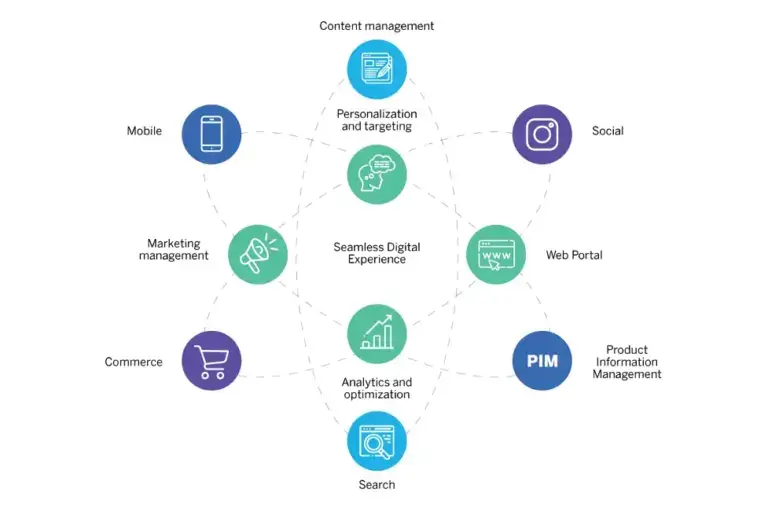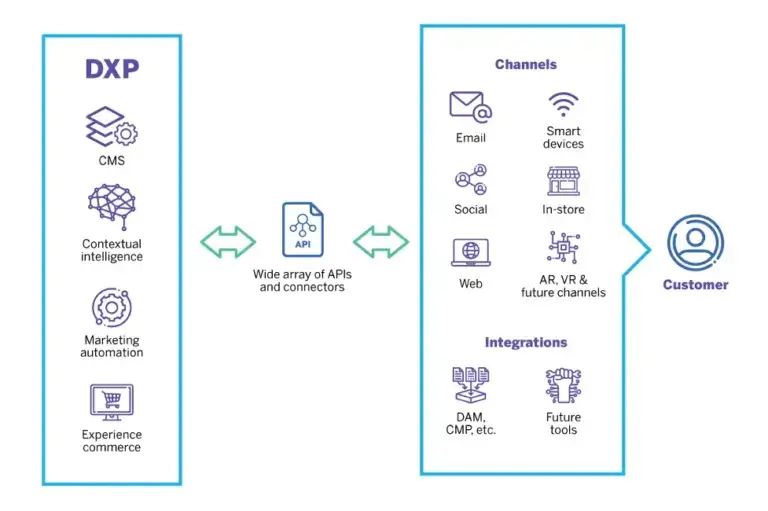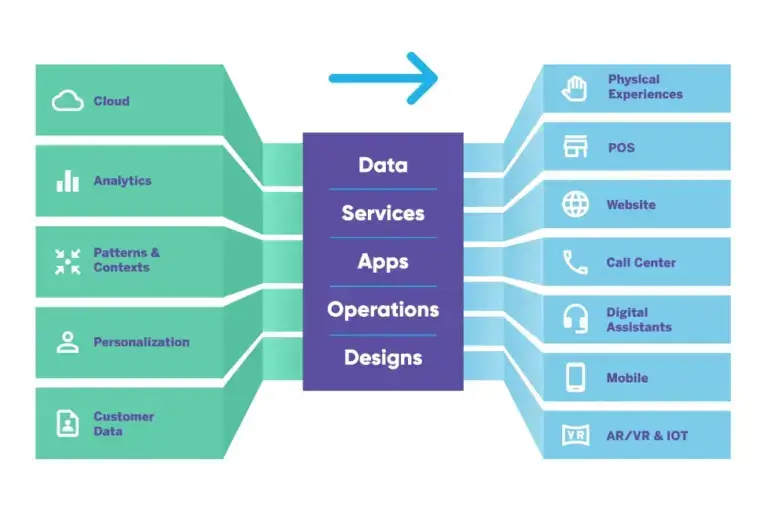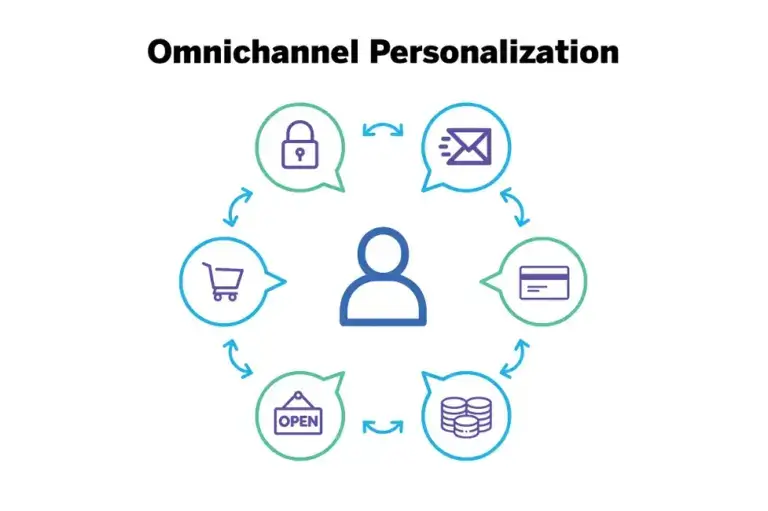What is a digital experience platform?
A digital experience platform (DXP) is a software suite designed to be a one-stop shop for creating, managing, and measuring the success of a company’s digital communications, commerce, and experiences.
In practical terms, that means bridging the gap between marketing communications, social media activity, web experiences, sales leads, customer information, customer support, and everything in between. A digital experience platform is a powerful tool for aligning sales, marketing, commerce, product, and service teams, where every single touchpoint and type of customer experience can be managed in one place.

Those capabilities can enable companies to build better relationships – between both departments and their customers. After all, having better-aligned systems and processes can help close experience gaps as well as sales loops.
A lot of digital experience platform offerings boast APIs that allow third-party tools to integrate and add to out-of-the-box feature sets. That means you can build out the right solution for your business by adding elements from various verticals – each of which can be managed and controlled centrally.
Free eBook: The Digital Experience Playbook
How have digital experience platforms evolved?
The modern digital experience platform is the result of years of technological evolution and industry-spanning digital transformation; they’re the descendants of older content management systems (CMS) and web experience management systems (WEM).
Content management systems
The humble content management system dates back to the early days of digital publishing, as the original tool used to publish content onto the internet. Typically, this would be the platform that allowed editors and site owners to upload static text and images.
These systems are still used today of course, (think WordPress, Drupal, or Sitefinity), but their limitations are fairly obvious if you’re a brand looking to link up everything from marketing to customer support. A CMS will let you publish content to an owned web channel and monitor traffic, but oftentimes miss the mark with limited practitioner tools, fewer agile features, or poor community support.
Web experience management systems
WEMs are an evolution of the content management system concept, bringing in a smarter layer of insights that can track user data and behavior across owned and third-party digital channels – including social media – to help businesses build audience profiles and provide more personalized marketing. These systems tend to be more about commerce than content.
The limitation there is that, while businesses that build their digital presence on WEMs will have access to much more useful data than those that simply produce content using a CMS, they’ll be missing out on a raft of information that can be shared and optimized across teams and departments.
Why are digital experience platforms important?
Bringing everything into one centralized tool is what lets digital-first businesses surface insights and optimizations that others can’t, and helps design more personalized customer experiences.
Across the entire customer journey, a digital experience platform can help connect the dots and build a digital-first pipeline that feels integrated and seamless. And that’s important because of how today’s customers interact with brands.
In our 2022 research, we found that 62% of consumers said businesses need to care more about them, and 60% of consumers would buy more as a result. Efficiency is also mission critical as McKinsey suggests that 75% expect a response within five minutes of having made contact.
None of this should come as a surprise, however. Demonstrably, today’s customers deal with companies in a much more free-flowing way. While traditional customer journeys might have involved being served some marketing, clicking a link to a website page, and then making a purchase, customers today are omnichannel users, who jump from channel to channel across a multitude of devices and platforms.
Ensuring that all those channels are aligned with a DXP can help you make sense of those seemingly chaotic journeys and still provide a way to direct customers down the sales funnel. Digital is here to stay. According to Adobe research, 82% of surveyed practitioners say their digital experience emphasis will either remain steady or accelerate, even as customers return to offline channels.
Enabling digital transformation
Digital experience platforms are the powerhouses of digital transformation. When companies look to overhaul their processes with digital tools, it’s rarely doable with small, piecemeal solutions. Instead, digital transformation requires a fundamental shift in thinking across the entire organization.

Imagine a house, and think about how you might go about making it more eco-friendly. Putting solar panels on the roof will help, but if the house is old and inefficient then you might never really feel the benefit. If you were to strip the house back to its bare bones and replace the wiring, insulation, and energy supply, efficiency would go through the roof.
It’s the same principle for businesses; a full digital transformation is a bigger process, but the results will be worth the effort. A digital experience platform is that insulation and wiring; it needs to be integrated right at the heart of the business.
What can digital experience platforms do?
We’ve mentioned that digital experience platforms sit at the heart of a truly digital business, but what does having that architecture allow you to do? Here are some of the benefits of centralizing your digital platforms:
Content management
Though much more sophisticated than a traditional content management system, a DXP can also act as a digital asset management system – one that can catalog, surface, and serve content across all your digital channels. So instead of having images, videos, and other media stored in separate content management systems for web, social, CRM, etc., all your assets are available in one CMS shared by every team and channel.
Ultimately, that level of content management saves time and resources by removing the need to duplicate design assets and breaking down silos so teams have access to every piece of customer data.
Use case example: A brand might use this technology to host video content for a new marketing campaign centrally, and publish it to every channel from that location, rather than posting it on social media and embedding it elsewhere.

eCommerce
DXP suites can power commerce and eCommerce, including security, customer account setup, inventory handling, and money transfers. This makes them the central operational hub for many businesses when it comes to order fulfillment.
Use case example: A digital experience platform can help a brand run its entire online store from one tool – with customer information saved as profiles, alongside live stock information and distribution management.
CRM
DXPs can also act as customer relationship manager suites, helping you keep tabs on multiple digital channels and customer portals in one place and in real-time, and ensuring you’re delivering highly contextual and personalized experiences at scale. That means they can help you build better relationships with your customers by leveraging data about your customers.
Use case example: A brand might use this CRM data to build customer profiles that can help them make smarter targeting choices in future – and avoid bombarding customers with irrelevant marketing material.
Analytics
With everything housed under one roof, digital experience platforms also become a powerful source of customer analytics and insights. The insights you’ll generate from this kind of seamless data collection can help you build more seamless customer journeys and close experience gaps.
Use case example: Customer service logs, behavioral data and purchasing reports can help identify problem areas – like issues with the checkout process, for instance – flagging pain points that need to be fixed in order to improve the overall customer experience.
Personalization
With insightful customer data, you can also deliver more personalized experiences across channels. For example, if your DXP suite spots an opportunity to provide a customer with a bespoke discount, you can do that without having to provide the same deal to customers who’re likely to purchase anyway.
Use case example: Brands can use DXPs to enable targeted offers and marketing efforts that they know will land with customers on an individual basis.
Experimentation
That kind of personalization allows for experimentation and marketing automation, with A/B testing of experiences, offers, and site design that can be intelligently tracked, measured, and monitored in real-time. Again, all that extra insight can help you make better-informed decisions about how to maximize your customer relationships, streamline your digital marketing, and make better use of digital experiences.
Use case example: DXPs can help brands deliver alternate versions of their web presence to different groups, and let them track how effective each one is at converting.

Futureproof flexibility
A DXP is a fundamentally flexible platform from which to build a truly digital-first business. Instead of trying to awkwardly bolt-on digital features to pre existing systems, most digital experience platforms are built for expansion – with APIs and integrations that play nice with any new system, software, or feature you might want to add later down the line.
The benefit is that as your business’ level of digital maturity increases, you can add tools that make your business smarter without diluting or complicating things; DXPs are able to integrate new technology right alongside existing parts of your technology stack.
Digital experience platforms vs traditional systems
As outlined above, there are a bunch of really compelling reasons to use a DXP in order to consolidate processes and systems that would otherwise remain siloed and hard to unify:
| With a DXP | With traditional, siloed systems |
|---|---|
| Consolidated customer info and insights | Data fragmented across different systems |
| Seamless cross-channel experiences | Inconsistent customer experiences |
| Unified brand and messaging | Complex integrations required |
| Agile adaptations to changing needs | Slower updates and optimizations |
| Accelerated digital innovation | Duplicative efforts across teams |
| Improved personalization | Limited data sharing |
| Integrated content across touchpoints | Redundant tools and costs |
| Streamlined IT environment | Teams operate in silos |
| Enhanced collaboration across teams | Poor visibility across initiatives |
| Future-proofed technology stack | Vendor lock-in risks |
What to look for in a digital experience platform?
If you’re looking to transform your business with a DXP, here’s what one should offer:
Cloud architecture
Cloud-based architecture not only ensures that your digital solutions are scalable, but also that they’re secure and up to date with the latest features. Any system that lives locally on company machines will have inherent limits to how widely accessible assets, information, and processes are between teams.
Security
DXPs deal with huge amounts of business and customer information, so it’s important that your chosen solution has security as a top priority. That means keeping important data points like passwords, addresses, and their communication history under lock and key via airtight encryption. It also means choosing a solution that was created with Privacy by Design at its core, meaning the product and engineering teams took privacy into account throughout the entire development process.
Adaptability
If you’re building a digital-first business, you’re building a business that’s ready to scale at any time. That means not painting yourself into a corner with a commerce or CMS that can’t be adapted later down the line. Your DXP should be able to work with third-party integrations and new technology suites via APIs.
Intelligence
Huge data sets need intelligent solutions to manage them. Tools like artificial intelligence, machine learning, and natural language processing can take the strain off of manually analyzing customer feedback and behavior – and help automatically highlight insights that can drive proactive business changes quicker and more effectively.
Top digital experience platforms
There are a host of digital experience platform solutions out there that can unify and simplify every aspect of your brand’s online presence – many of which work with Qualtrics’ own XM Platform® for added customer and brand insights. Here’s just a handful of suggestions:
Adobe Experience Manager
Part of Adobe Experience Cloud, Adobe Experience Manager provides a suite of applications for content creation, analytics, personalization, campaign management, real-time customer data, and more. It aims to bring customer experience capabilities into one integrated platform. On top of this, Adobe boasts integration across its own tools like Adobe Analytics and Adobe Target.
Salesforce Experience Cloud
Salesforce offers a unified CRM platform that encompasses sales, service, commerce, marketing, and more – connecting data across all these systems to enable personalized customer journeys. Salesforce’s tailored solutions and its robust AppExchange ecosystem are built for a range of different industries.
Liferay Digital Experience Platform (DXP)
Liferay DXP is an open source platform for building digital experiences with integrated portal, content, forms and workflow capabilities. It offers the flexibility to adapt solutions for different use cases, alongside an ecosystem of developers and partners. It offers brands ease of integration and a quick time-to-market.
Acquia Platform
Acquia offers an open DXP that comprises Acquia Lift for personalization and Acquia Journey for customer journeys. Acquia focuses on content-driven experiences with AI-powered capabilities, with cloud hosting optimized for Drupal.
Optimizely Digital Experience Platform
Optimizely’s DXP is focused on content management, delivery and optimization. It provides authoring, workflows, analytics, personalization and omnichannel publishing. The platform emphasizes developer-friendly APIs and a range of scalable integrations.
The future of DXPs
The key future trends to look out for in the digital experience platform space are AI and an increased focus on omnichannel reach. With AI, DXPs offer far greater data gathering abilities, with rich customer profiling, information, context and insights all captured and generated automatically. This technology will help brands offer better personalization for each customer, as well as smarter customer journeys that lean on real user data to inform changes.
An increased omnichannel focus, meanwhile, will help tomorrow’s DXPs enable brands to deliver consistent, unified experiences across every touchpoint. The more this technology evolves, the better connected each channel and touchpoint will become – and more streamlined customer journeys will follow suit.
In summary…
The transition toward truly all-encompassing digital experience platforms lets businesses integrate everything from their business intelligence analytics and CRM suites, to their cloud platform infrastructure and audience profiling tools – bringing everything under one roof.
Increasingly, bringing all these business elements under one virtual roof will provide brands the opportunity to provide customers with digital shopping experiences that go above and beyond what’s been possible with traditionally siloed applications.
And it’s that tighter attention to customer needs and more intelligent digital experiences that will help brands stand out. In an age when the customer experience is paramount, using the latest technology and streamlining processes is the surest way to win new business and drive up customer loyalty.
As we look to the near future, DXP’s are poised to redefine the intersection of technology and customer engagement. The next wave will likely see DXPs harnessing the power of AI to deliver even more personalized, anticipatory experiences that adapt in real-time to customer behavior and preferences. Looking even further ahead we could see the integration of emerging technologies such as augmented reality and the Internet of Things (IoT) which will further dissolve the boundaries between digital and physical realms, creating a seamless and immersive customer journey.
Free eBook: The Digital Experience Playbook